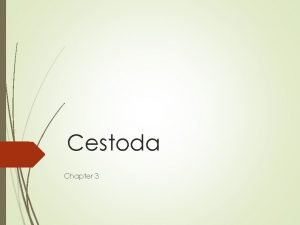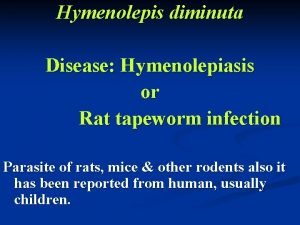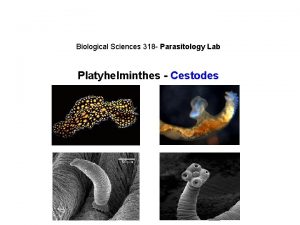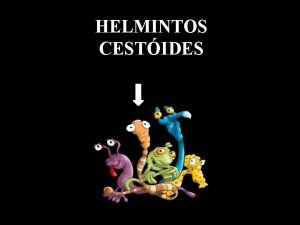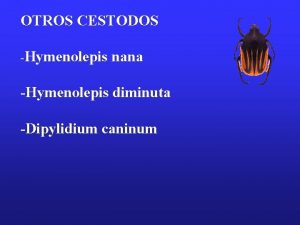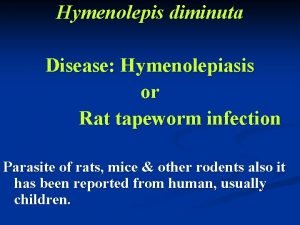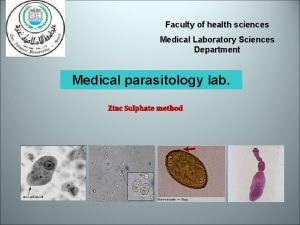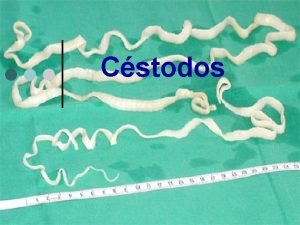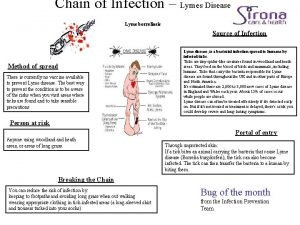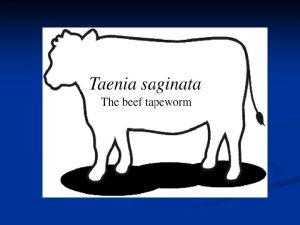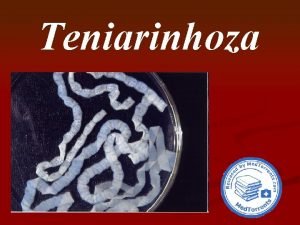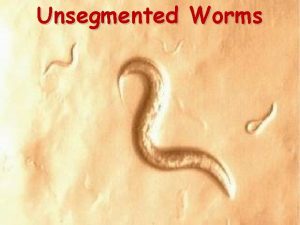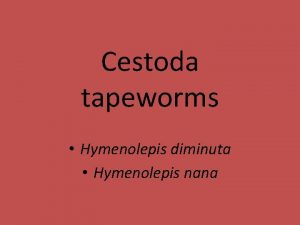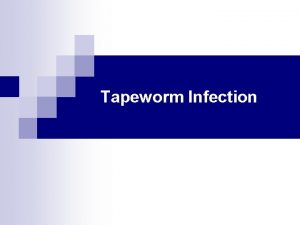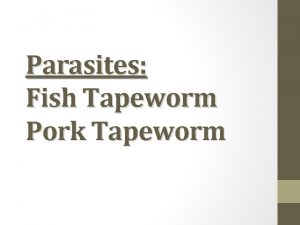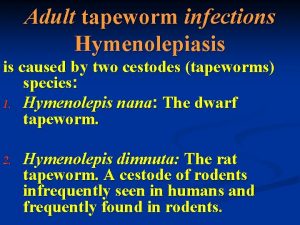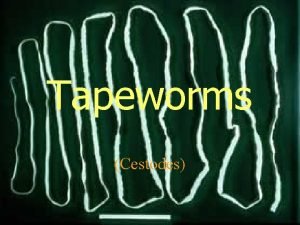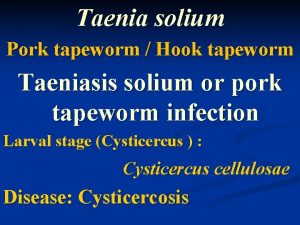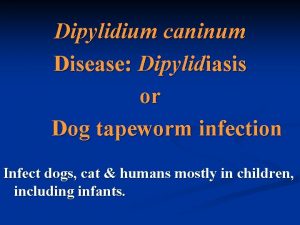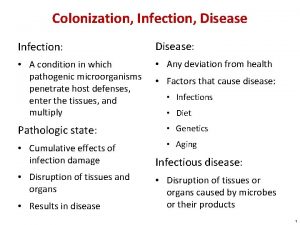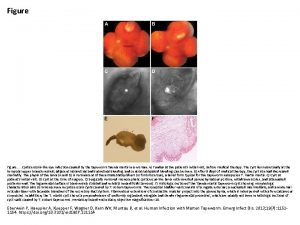Hymenolepis diminuta Disease Hymenolepiasis or Rat tapeworm infection



















- Slides: 19

Hymenolepis diminuta Disease: Hymenolepiasis or Rat tapeworm infection Parasite of rats, mice & other rodents also it has been reported from human, usually children.

Epidemiology n World wide. n Common among children due to ingestion of infected grain beetles, dried fruits, flour and cereals. n Prevalence of H. diminuta in Philippine rats is about 8%.

Common parasite of rats and mice. ♣ Accidental human infections. ♣ Differs from Hymenolepis nana in morphology and life cycle because it requires an intermediate host. ♣ 2 Hosts: § Larval stage: cysticercoid is passed in fleas. § Adult stage: in rats and mice and accidentally in humans especially children who accidentally ingest infected ♣

Morphology: v Adult larger than Hymenolepis nana. v Measure 20 -60 cm. X 3. 54. 0 mm. It contain 1000 or more proglottids. v Scolex is provided with 4 - small suckers and a rudimentary unarmed rostellum. v The neck is short and stout.

Scolex of Hymenolepis diminuta

v Mature segment: wider than long testes 3 globes mid-lateral genital pore. v Gravid proglottids usually disintegrate while still attached to the strobila, liberating fully embryonated ovoid to subspherical eggs.

MP of H. diminuta GP of H. diminuta segments of H. diminuta Note : just larger than H. nana

v Egg: there is a space between the tanned outer membrane and the inner one. The latter one is provided with a pair of polar thickenings, but lacks the polar filaments the characteristic of H. nana eggs.

Iodine stain Ova of H. diminuta, stool smear 201


Cysticercoid of Hymenolepis diminuta: This larva has no bladder, but instead has a tail. n The dark body within the spherical portion is the scolex. n The longer the tail, the more mature cysticercoid. n This stage is found inside an insect such as the mealworm. n

Life cycle: | Eggs of Hymenolepis diminuta are passed out in the feces of the infected definitive host (rodents & man). | The mature eggs are ingested by an intermediate host (various arthropod adults or larvae). | Oncospheres are released from the eggs and penetrate the intestinal wall of the host, which develop into cysticercoid larvae.

| The cysticercoid larvae persist through the arthropod's morphogenesis to adulthood. | H. diminuta infection is acquired by the mammalian host after ingestion of an intermediate host carrying the cysticercoid larvae. | Humans can be accidentally infected through the ingestion of insects in precooked cereals, or other food items, and directly from the environment (e. g. , oral exploration of the environment by children).

| After ingestion, the tissue of the infected arthropod is digested releasing the cysticercoid larvae in the stomach and small intestine. | Eversion of the scoleces occurs shortly after the cysticercoid larvae are released. | Using the four suckers on the scolex, the parasite attaches to the small intestine wall.

| Maturation of the parasites occurs within 20 days. | Eggs are released in the small intestine from gravid proglottids that disintegrate after breaking off from the adult worms. | The eggs are expelled to the environment in the mammalian host's feces.

Hymenolepis diminuta life cycle

Pathogenesis & Symptoms: H. diminuta infection usually produce no symptoms. Worm burden in rodents is relatively low.

Diagnosis: Stool examination Diagnostic stage: egg.

Treatment: Similar to H. nana infection. (Praziquantel 25 mg/kg body weight single dose). Control: Eradicate rats around the home.
 Metagonimus yokogawai
Metagonimus yokogawai H diminuta ova
H diminuta ova Eucestoda
Eucestoda Hymenolepis diminuta
Hymenolepis diminuta Hymenolepis nana hospedero intermediario
Hymenolepis nana hospedero intermediario Hymenolepiasis
Hymenolepiasis Hymenolepis nana scolex
Hymenolepis nana scolex Taenia solium
Taenia solium Sing 1 rat
Sing 1 rat Diseases spread by pathogens
Diseases spread by pathogens Chapter 19 disease transmission and infection prevention
Chapter 19 disease transmission and infection prevention Chain of infection for lyme disease
Chain of infection for lyme disease Chapter 19 disease transmission and infection prevention
Chapter 19 disease transmission and infection prevention Puncture resistant container
Puncture resistant container Bharathi viswanathan
Bharathi viswanathan Hookless tapeworm
Hookless tapeworm Rebecca rawlings
Rebecca rawlings Life cycle of taenia saginata
Life cycle of taenia saginata Parasite life cycle
Parasite life cycle Pinworms and hookworms belong to the phylum
Pinworms and hookworms belong to the phylum
